Abstract
1 In a double-blind cross-over study, nine healthy male students received placebo, brompheniramine 12 mg), carbinoxamine (12 mg), clemastine (1 mg), and phenylpropanolamine (50 mg) orally. Three doses of each drug were given: at 08.30 h and 21.00 h on the first day of treatment and at 08.30 h on the following day. 2 Psychomotor skills and subjective feelings were recorded before and 2, 6 and 12 h after the first dose on day 1 as well as before and 2 and 6 h after the third dose on day 2. Subjective appraisals of sleep were requested on the morning of day 2. 3 All antihistamines tended to cause subjective drowsiness on the first day of treatment. Drowsiness was felt for a maximum of 2 h after carbinoxamine, 6 h after brompheniramine, and 12 h after clemastine. In contrast to antihistamines, phenylpropanolamine made subjects more alert and quick witted. Tolerance to the antihistamine-induced drowsiness developed on the second day. 4 Divided attention, tracking, speed anticipation and sleep were not affected by any drug. Carbinoxamine slowed reactions 2 h after the first dose, but no impairment was measured in objective tests after brompheniramine or clemastine. 5 Phenylpropanolamine improved reaction speed and reaction accuracy and enhanced flicker recognition throughout the study. Phenylpropanolamine plasma levels and improvement in flicker fusion test results correlated with each other on day 2. 6 The results suggest that phenylpropanolamine and the antihistamines studied are comparatively harmless to psychomotor performance and driving skills.
Full text
PDF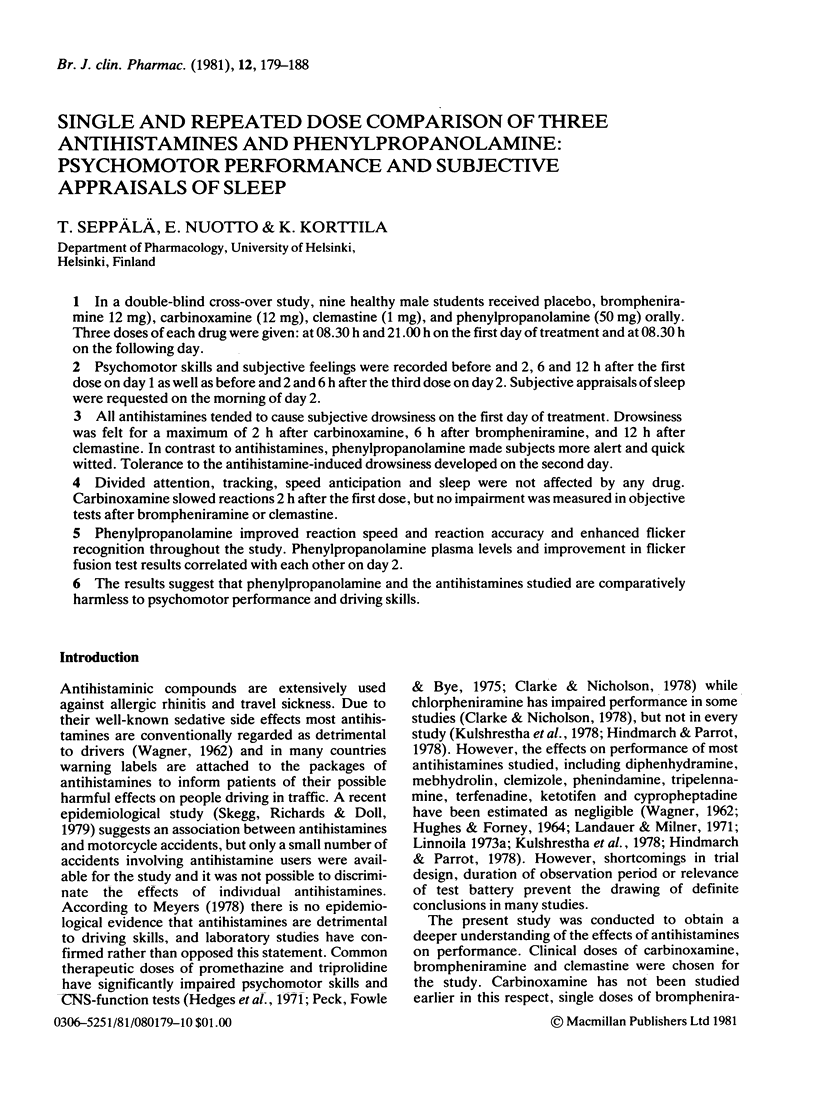

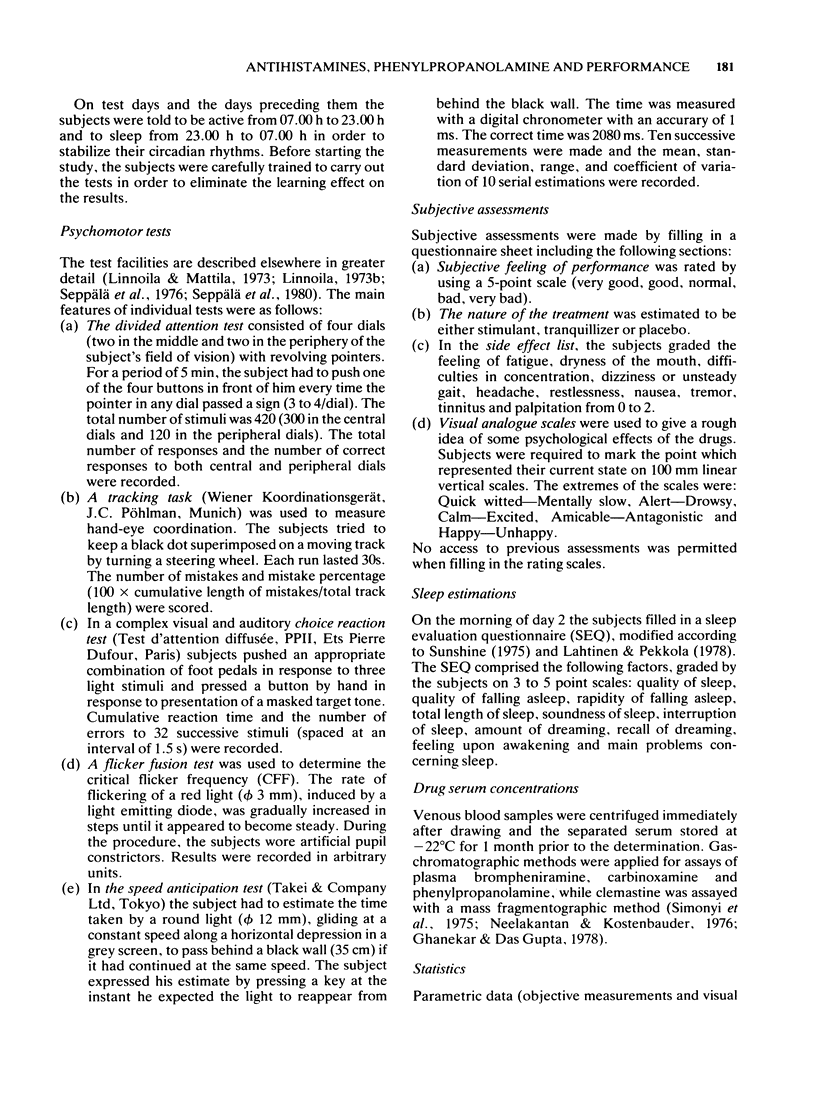
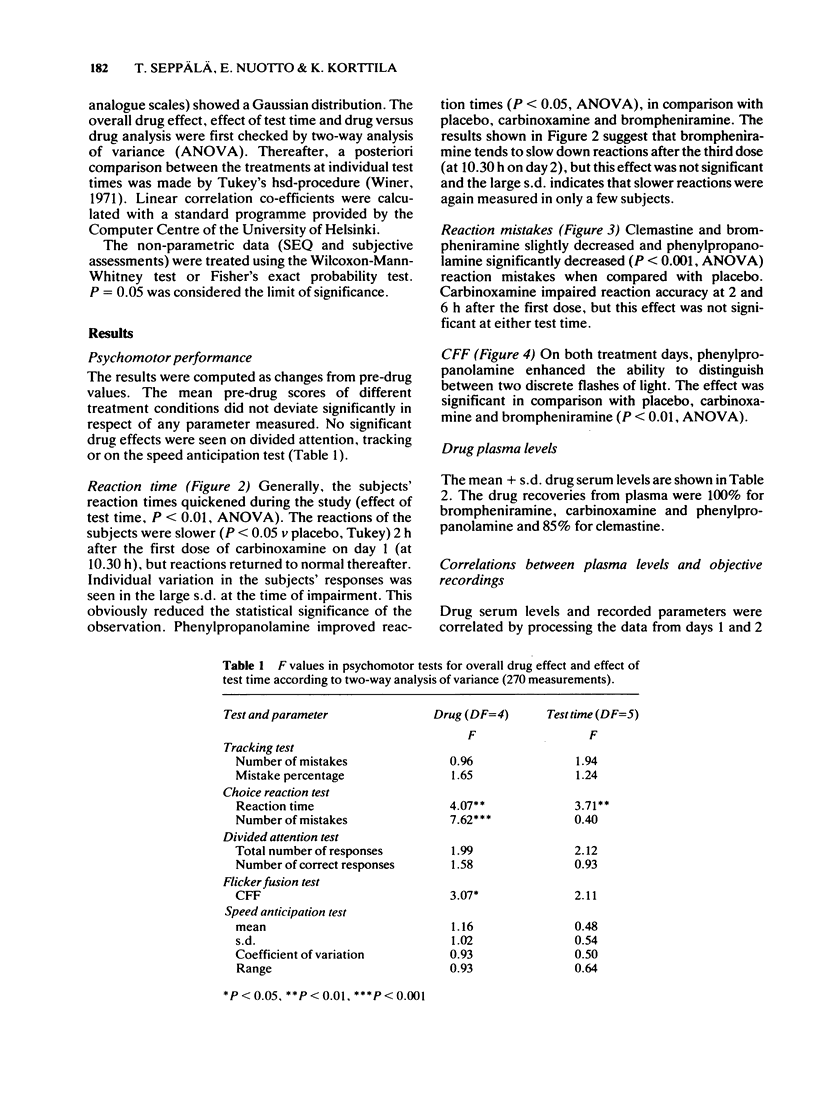
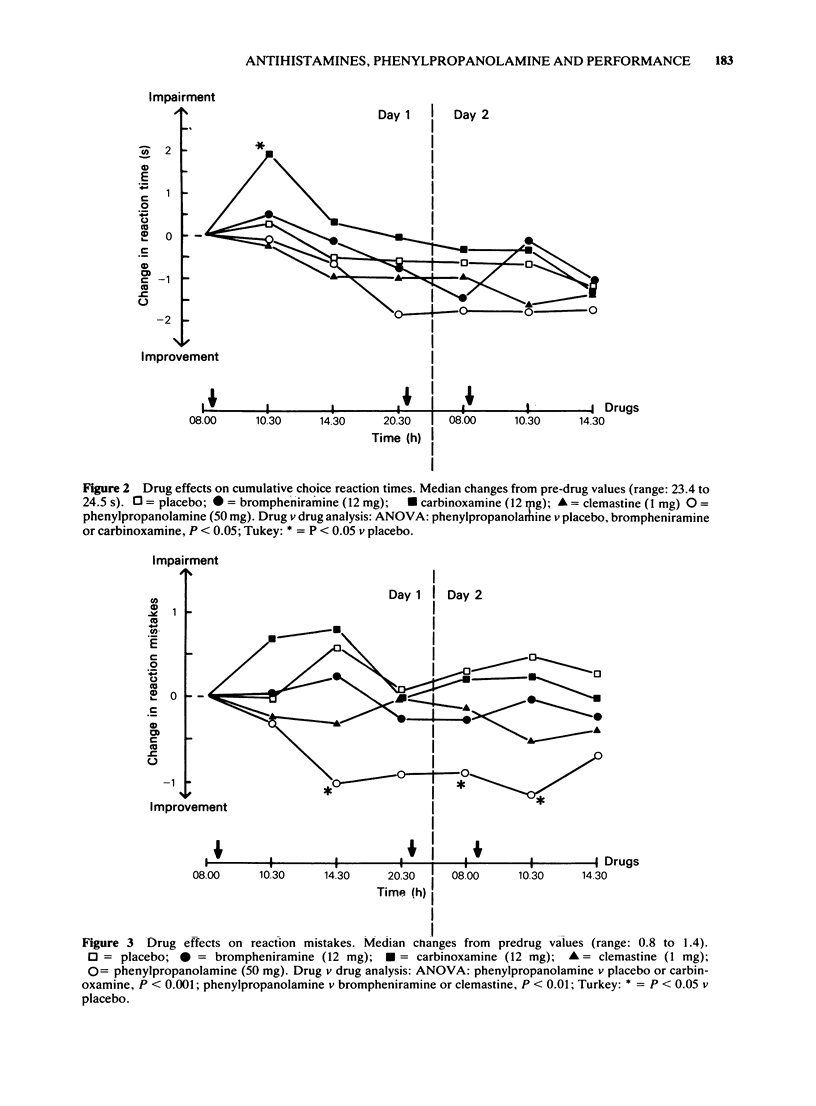
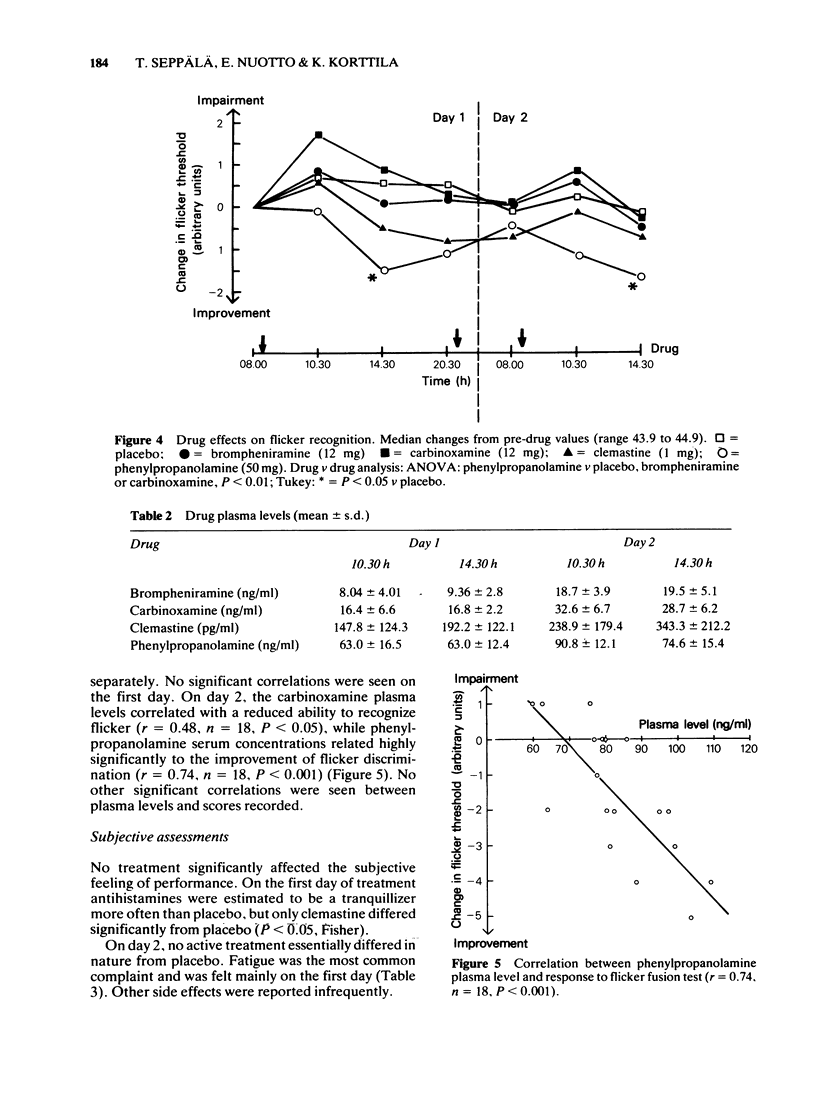
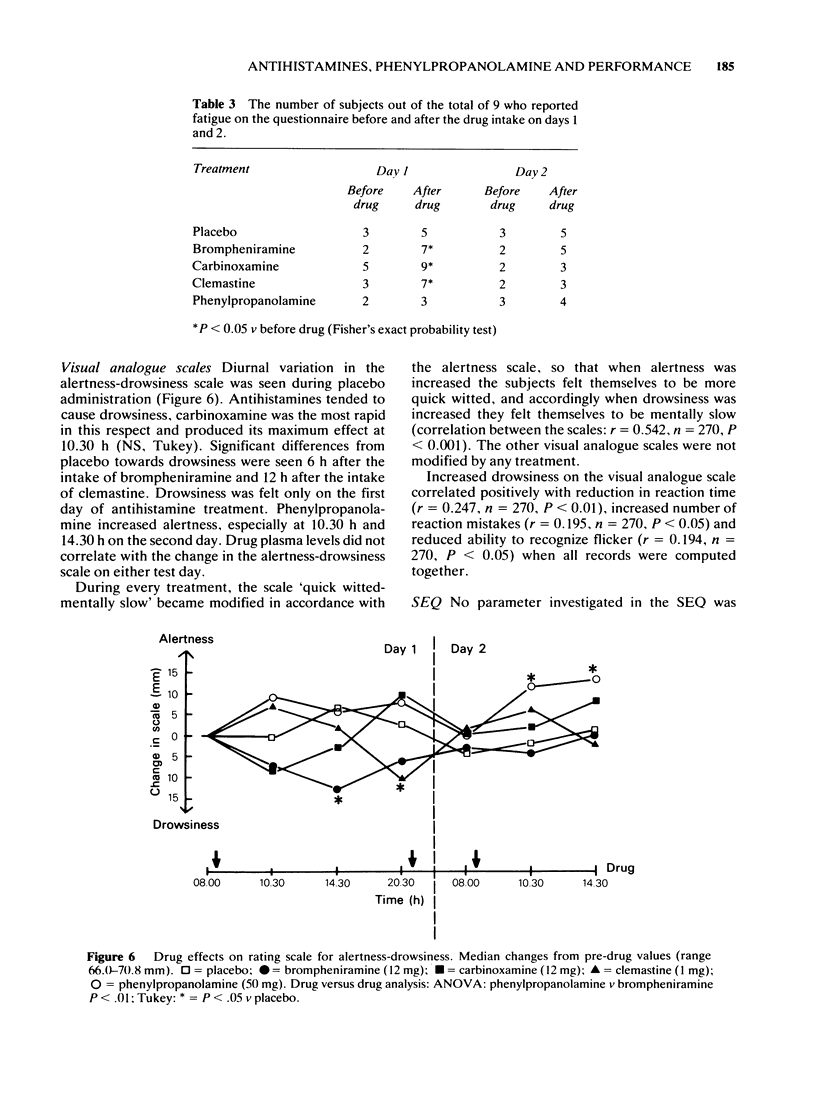
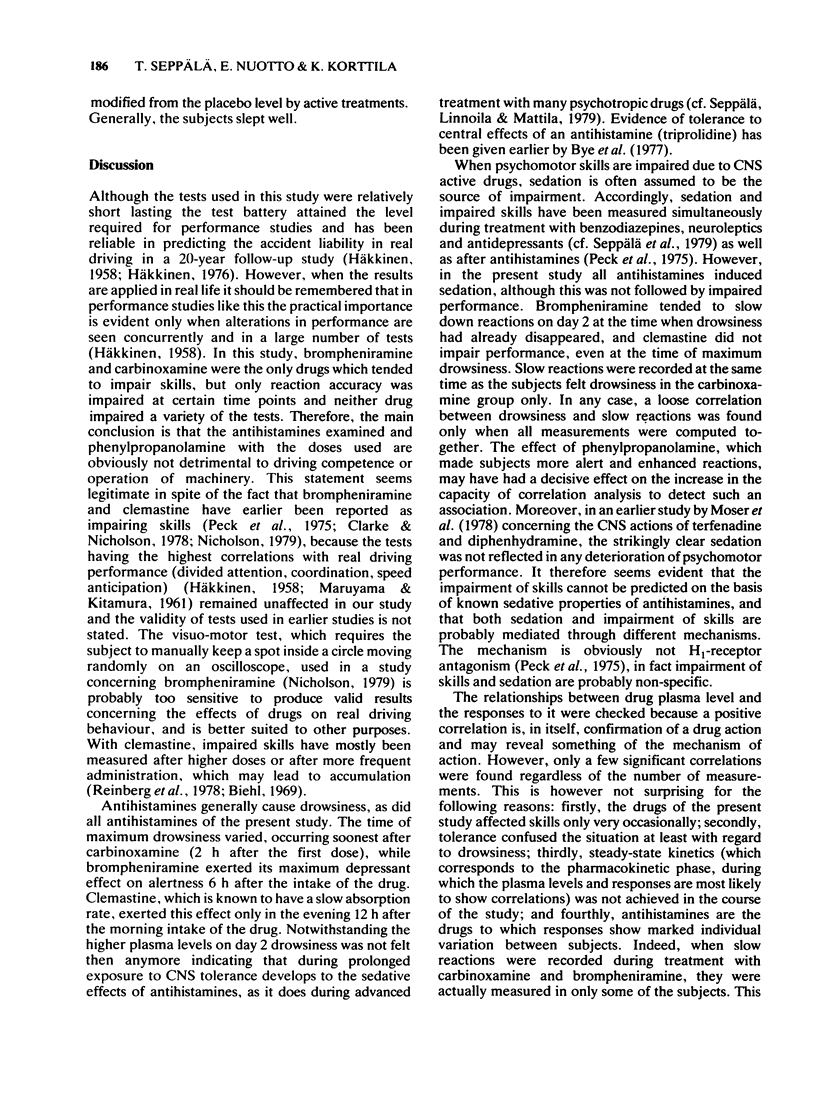
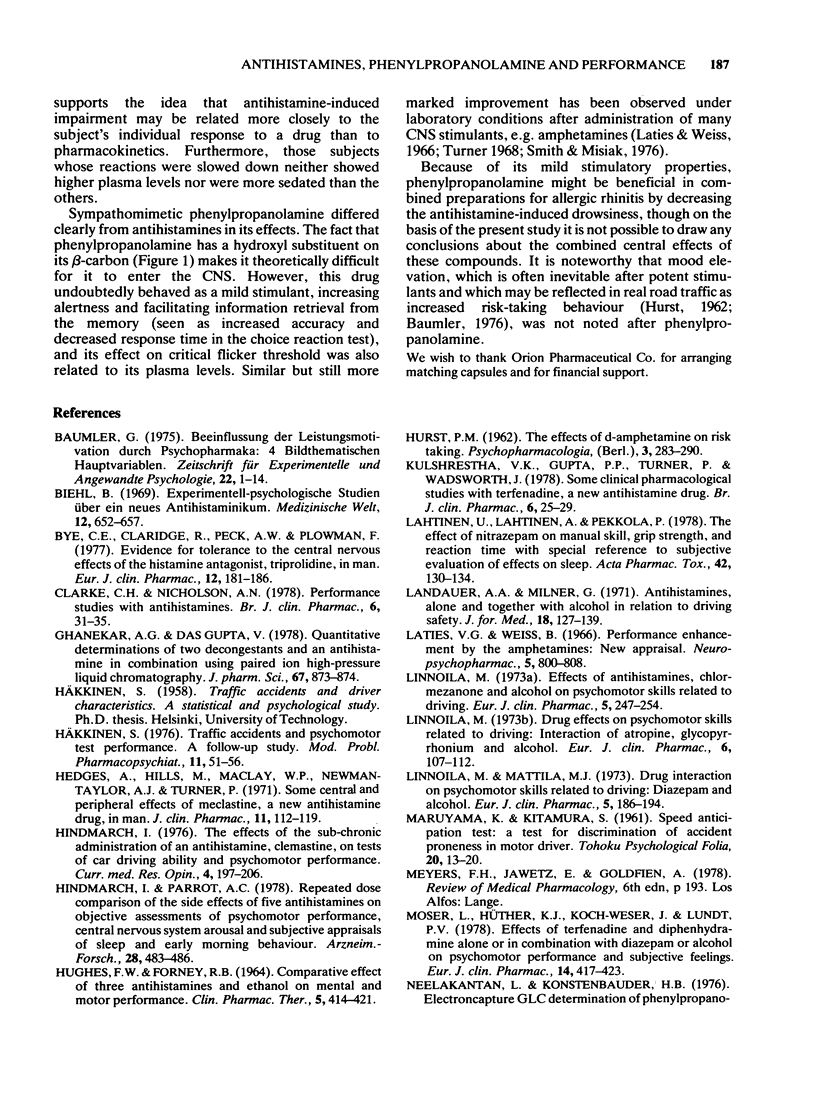
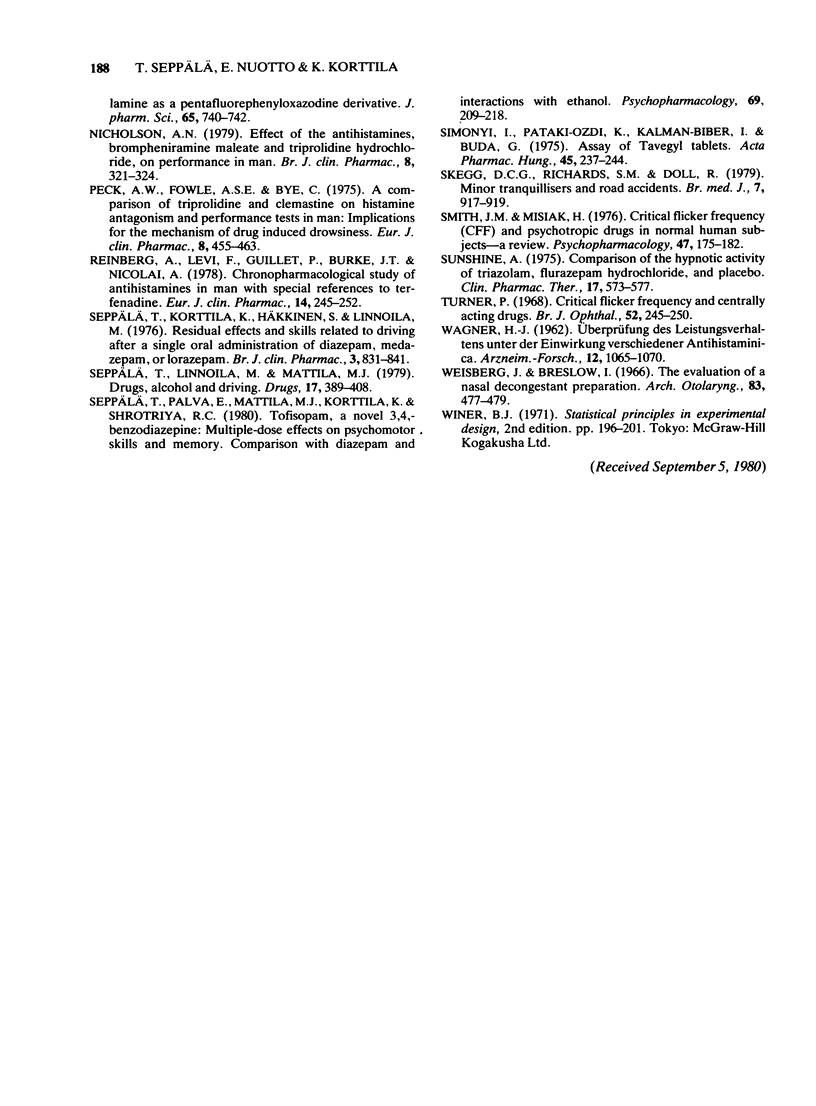
Selected References
These references are in PubMed. This may not be the complete list of references from this article.
- Biehl B. Experimentell-psychologische Studien über ein neues Antihistaminikum. Die verschiedenen Leistungsfunktionen im Hinblick auf die Fahrtüchtigkeit. Med Welt. 1969 Mar 22;12:652–657. [PubMed] [Google Scholar]
- Bye C. E., Claridge R., Peck A. W., Plowman F. Evidence for tolerance to the central nervous effects of the histamine antagonist, triprolidine, in man. Eur J Clin Pharmacol. 1977 Nov 14;12(3):181–186. doi: 10.1007/BF00609857. [DOI] [PubMed] [Google Scholar]
- Bäumler G. Beeinflussung der leistungmotivation durch psychopharmaka: I. Die 4 bildthematischen Hauptvariablen. Z Exp Angew Psychol. 1975;22(1):1–14. [PubMed] [Google Scholar]
- Clarke C. H., Nicholson A. N. Performance studies with antihistamines. Br J Clin Pharmacol. 1978 Jul;6(1):31–35. doi: 10.1111/j.1365-2125.1978.tb01678.x. [DOI] [PMC free article] [PubMed] [Google Scholar]
- Ghanekar A. G., Das Gupta V. Quantitative determinations of two decongestants and an antihistamine in combination using paired ion high-pressure liquid chromatography. J Pharm Sci. 1978 Jun;67(6):873–874. doi: 10.1002/jps.2600670643. [DOI] [PubMed] [Google Scholar]
- HUGHES F. W., FORNEY R. B. COMPARATIVE EFFECT OF THREE ANTIHISTAMINICS AND ETHANOL ON MENTAL AND MOTOR PERFORMANCE. Clin Pharmacol Ther. 1964 Jul-Aug;5:414–421. doi: 10.1002/cpt196454414. [DOI] [PubMed] [Google Scholar]
- HURST P. M. The effects of d-amphetamine on risk taking. Psychopharmacologia. 1962 Oct 5;3:283–290. doi: 10.1007/BF00411368. [DOI] [PubMed] [Google Scholar]
- Hedges A., Maclay W. P., Newman-Taylor A. J., Turner P. Some central and peripheral effects of meclastine, a new antihistaminic drug, in man. J Clin Pharmacol New Drugs. 1971 Mar-Apr;11(2):112–119. doi: 10.1177/009127007101100206. [DOI] [PubMed] [Google Scholar]
- Hindmarch I., Parrott A. C. A repeated dose comparison of the side effects of five antihistamines on objective assessments of psychomotor performance, central nervous system arousal and subjective appraisals of sleep and early morning behaviour. Arzneimittelforschung. 1978;28(3):483–486. [PubMed] [Google Scholar]
- Hindmarch I. The effects of the sub-chronic administration of an anti-histamine, clemastine, on tests of car driving ability and psychomotor performance. Curr Med Res Opin. 1976;4(3):197–206. doi: 10.1185/03007997609109303. [DOI] [PubMed] [Google Scholar]
- Häkkinen S. Traffic accidents and psychomotor test performance. A follow-up study. Mod Probl Pharmacopsychiatry. 1976;11:51–56. [PubMed] [Google Scholar]
- Kulshrestha V. K., Gupta P. P., Turner P., Wadsworth J. Some clinical pharmacological studies with terfenadine, a new antihistamine drug. Br J Clin Pharmacol. 1978 Jul;6(1):25–29. doi: 10.1111/j.1365-2125.1978.tb01677.x. [DOI] [PMC free article] [PubMed] [Google Scholar]
- Lahtinen U., Lahtinen A., Pekkola P. The effect of nitrazepam on manual skill, grip strength, and reaction time with special reference to subjective evaluation of effects on sleep. Acta Pharmacol Toxicol (Copenh) 1978 Feb;42(2):130–134. doi: 10.1111/j.1600-0773.1978.tb02180.x. [DOI] [PubMed] [Google Scholar]
- Linnoila M. Drug effects on psychomotor skills related to driving: interaction of atropine, glycopyrrhonium and alcohol. Eur J Clin Pharmacol. 1973 Aug;6(2):107–112. doi: 10.1007/BF00562436. [DOI] [PubMed] [Google Scholar]
- Moser L., Hüther K. J., Koch-Weser J., Lundt P. V. Effects of terfenadine and diphenhydramine alone or in combination with diazepam or alcohol on psychomotor performance and subjective feelings. Eur J Clin Pharmacol. 1978 Dec 18;14(6):417–423. doi: 10.1007/BF00716383. [DOI] [PubMed] [Google Scholar]
- Neelakantan L., Kostenbauder H. B. Electron-capture GLC determination of phenylpropanolamine as a pentofluorophenyloxazolidine derivative. J Pharm Sci. 1976 May;65(5):740–742. doi: 10.1002/jps.2600650530. [DOI] [PubMed] [Google Scholar]
- Nicholson A. N. Effect of the antihistamines, brompheniramine maleate and triprolidine hydrochloride, on performance in man. Br J Clin Pharmacol. 1979 Oct;8(4):321–324. doi: 10.1111/j.1365-2125.1979.tb04712.x. [DOI] [PMC free article] [PubMed] [Google Scholar]
- Peck A. W., Fowle A. S., Bye C. A comparison of triprolidine and clemastine on histamine antagonism and performance tests in man: implications for the mechanism of drug induced drowsiness. Eur J Clin Pharmacol. 1975 Aug 14;8(6):455–463. doi: 10.1007/BF00562321. [DOI] [PubMed] [Google Scholar]
- Reinberg A., Levi F., Guillet P., Burke J. T., Nicolai A. Chronopharmacological study of antihistamines in man with special references to terfenadine. Eur J Clin Pharmacol. 1978 Dec 1;14(4):245–252. doi: 10.1007/BF00560457. [DOI] [PubMed] [Google Scholar]
- Seppala T., Linnoila M., Mattila M. J. Drugs, alcohol and driving. Drugs. 1979 May;17(5):389–408. doi: 10.2165/00003495-197917050-00008. [DOI] [PubMed] [Google Scholar]
- Seppälä K., Korttila K., Häkkinen S., Linnoila M. Residual effects and skills related to driving after a single oral administration of diazepam, medazepam or lorazepam. Br J Clin Pharmacol. 1976 Oct;3(5):831–841. doi: 10.1111/j.1365-2125.1976.tb00635.x. [DOI] [PMC free article] [PubMed] [Google Scholar]
- Seppälä T., Palva E., Mattila M. J., Korttila K., Shrotriya R. C. Tofisopam, a novel 3,4-benzodiazepine: multiple-dose effects on psychomotor skills and memory. Comparison with diazepam and interactions with ethanol. Psychopharmacology (Berl) 1980;69(2):209–218. doi: 10.1007/BF00427652. [DOI] [PubMed] [Google Scholar]
- Simonyi I., Pataki S., Kálmán K., Buda L. Tavegyl tabletta hatóanyag-tartalmának meghatározása. Acta Pharm Hung. 1975 Nov;45(6):237–244. [PubMed] [Google Scholar]
- Skegg D. C., Richards S. M., Doll R. Minor tranquillisers and road accidents. Br Med J. 1979 Apr 7;1(6168):917–919. doi: 10.1136/bmj.1.6168.917. [DOI] [PMC free article] [PubMed] [Google Scholar]
- Smith J. M., Misiak H. Critical flicker frequency (CFF) and psychotropic drugs in normal human subjects-a review. Psychopharmacologia. 1976 May 28;47(2):175–182. doi: 10.1007/BF00735818. [DOI] [PubMed] [Google Scholar]
- Sunshine A. Comparison of the hypnotic activity of triazolam, flurazepam hydrochloride, and placebo. Clin Pharmacol Ther. 1975 May;17(5):573–577. doi: 10.1002/cpt1975175573. [DOI] [PubMed] [Google Scholar]
- Turner P. Critical flicker frequency and centrally-acting drugs. Br J Ophthalmol. 1968 Mar;52(3):245–250. doi: 10.1136/bjo.52.3.245. [DOI] [PMC free article] [PubMed] [Google Scholar]
- Weisberg J., Breslow I. The evaluation of a nasal decongestant preparation. Arch Otolaryngol. 1966 May;83(5):477–479. doi: 10.1001/archotol.1966.00760020479014. [DOI] [PubMed] [Google Scholar]


